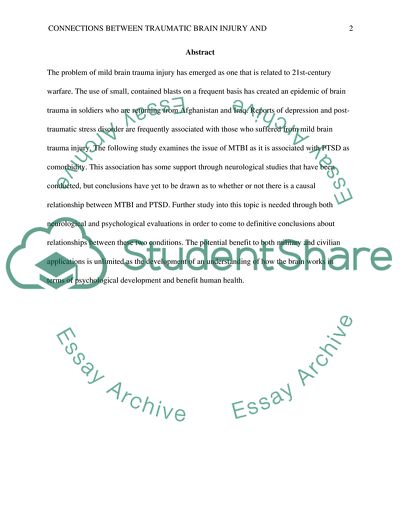Cite this document
(Connections between Traumatic Brain Injury and Post Traumatic Stress D Research Paper, n.d.)
Connections between Traumatic Brain Injury and Post Traumatic Stress D Research Paper. https://studentshare.org/health-sciences-medicine/1847924-write-a-literature-review-research-paper-about-the-following-question-does-traumatic-brain-injuries-sustained-from-battlefields-increase-the-risk-of-ptsd-for-us-veterans-ages-18-35-who-served-during-the-afghanistan-and-iraq-wars
Connections between Traumatic Brain Injury and Post Traumatic Stress D Research Paper. https://studentshare.org/health-sciences-medicine/1847924-write-a-literature-review-research-paper-about-the-following-question-does-traumatic-brain-injuries-sustained-from-battlefields-increase-the-risk-of-ptsd-for-us-veterans-ages-18-35-who-served-during-the-afghanistan-and-iraq-wars
(Connections Between Traumatic Brain Injury and Post Traumatic Stress D Research Paper)
Connections Between Traumatic Brain Injury and Post Traumatic Stress D Research Paper. https://studentshare.org/health-sciences-medicine/1847924-write-a-literature-review-research-paper-about-the-following-question-does-traumatic-brain-injuries-sustained-from-battlefields-increase-the-risk-of-ptsd-for-us-veterans-ages-18-35-who-served-during-the-afghanistan-and-iraq-wars.
Connections Between Traumatic Brain Injury and Post Traumatic Stress D Research Paper. https://studentshare.org/health-sciences-medicine/1847924-write-a-literature-review-research-paper-about-the-following-question-does-traumatic-brain-injuries-sustained-from-battlefields-increase-the-risk-of-ptsd-for-us-veterans-ages-18-35-who-served-during-the-afghanistan-and-iraq-wars.
“Connections Between Traumatic Brain Injury and Post Traumatic Stress D Research Paper”. https://studentshare.org/health-sciences-medicine/1847924-write-a-literature-review-research-paper-about-the-following-question-does-traumatic-brain-injuries-sustained-from-battlefields-increase-the-risk-of-ptsd-for-us-veterans-ages-18-35-who-served-during-the-afghanistan-and-iraq-wars.


